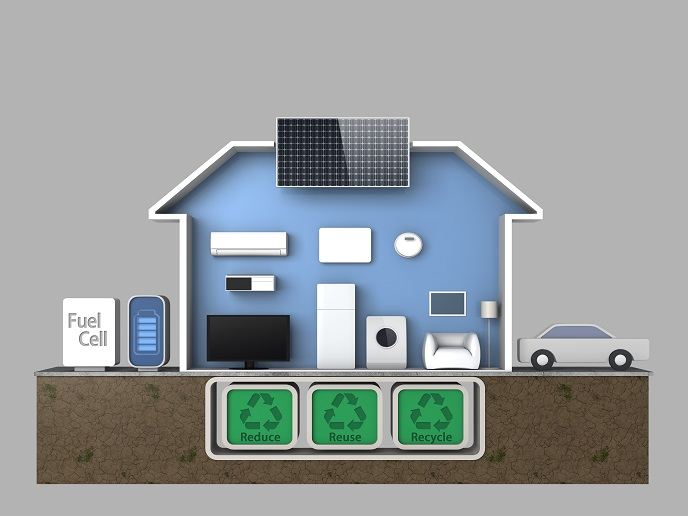Smarter windows, smarter energy management
The new window includes a hybrid film composed of an electrochromic LC film and a photovoltaic film both printed on the same long-lasting flexible substrate. The hybrid film is created using electrochromic and photovoltaic inks specially formulated for ink-jet printing. Combining the hybrid film with an appropriate window frame is expected to result in a reduction of the window’s U-value down to 0.3 W/m² K. Other important aspects of the SMARTBLIND(opens in new window) (Development of an active film for smart windows with inkjet method. Application to a building envelope component: autonomous smart device) project are the related parts, such as connectors and film control, sustainability, life cycle and recyclability. The SMARTBLIND product targets both the new building and renovation markets. Dr. Pierre Sixou, project coordinator from Polymage s.a.r.l. France, discusses the results of the project, which was completed in August 2015. Can you provide some details on the results of SMARTBLIND? The SMARTBLIND consortium had four main objectives, two of which have been reached. First, we obtained satisfying results in our efforts to reduce frame and window weight. The weight reduction achieved was even lower than 50%, which was our initial goal. A process was also implemented to improve the transparency and flexibility of the active electrochromic film. Secondly, we managed to improve the optical response time of windows while enabling the switching of large panes. Large panes of 1.5 m with fast response times — a fraction of second — were achieved. The last two points, which consisted respectively in integrating an electronic control system with an embedded power source and to guarantee a low-cost industrial solution adaptable to large and shaped surfaces, are still being worked on. Part of the electronic system was integrated but due to a lack of time the final trials on demonstration windows were done without complete electronics embedded. The ambitious aim to guarantee a low cost industrial solution was not wholly reached either. However it is important to note that a detailed action will be included in an up-scaling programme and that shaped surfaces can already be realised. For one of the three demonstrators with a square metre surface a solid basis for a process up scaling was implemented. How much do you expect the technology to cost? How competitive will it be with existing technologies? The aim was to obtain a smart window with the same price as a window with specialty glass panes. This aim was not wholly reached but seems reachable. In fact, it is necessary to specify the type of smart window because there are so many possible options: a device with or without embedded electronics, with or without energy autonomy, with more or less control etc. A lot of SMARTBLIND sub-products exist. Some of them are highly competitive. To compare we have taken as a reference the current smart window from SAGE that is offered at a price between EUR 500-2000/m2, depending on the project. How easy or difficult will the technology be to commercialise? For a ‘quasi perfect’ smart window that includes all the SMARTBLIND functionalities such as a fast response time, dimming, embedded electronics (and communication between the window and the final user), energy autonomy…the market is accessible now mainly to big companies that already have an international presence in the field and are committed long-term to smart windows. For SMEs, as is the case with the majority of the SMARTBLIND partners, the best way to access the market is to choose a SMARTBLIND sub-product that is the most adapted to develop and can reach a niche market. This is possible for specific SMARTBLIND sub-products. A project start up is being created on a specific SMARTBLIND sub-product. Which are the most promising application areas? Mainly ‘prestige buildings’ in conventional as well as in textile architecture to start with. This first approach will then allow businesses to address the larger markets such as buildings in the services sector and residential buildings. SMARTBLIND sub-products, especially for solar and visual control in transportation (cars, trains, etc.) could be launched, but before that a value analysis would be needed to drastically lower their prices relative to the prices currently charged on the market, especially for car devices. What are the main benefits provided by the technology? The SMARTBLIND technology has three major advantages: multi-functionality (solar and light control), energy autonomy and a large number of applications. As to the quantitative aspect, the modification of the solar factor is around 20% but could be improved. When will more results (even if preliminary) become available? The answers depends mainly on the funds available on complementary aspects: improving active films and up-scaling. Up scaling actions should start now. As the project is completed, what will be the next steps? How do you see the technology evolving in the future? The natural evolution was to push ‘up-scaling’ for the demonstration windows that were the most promising, and then to put them on ‘model building’. Among the demonstration windows produced, one of them fit this scenario very well.







